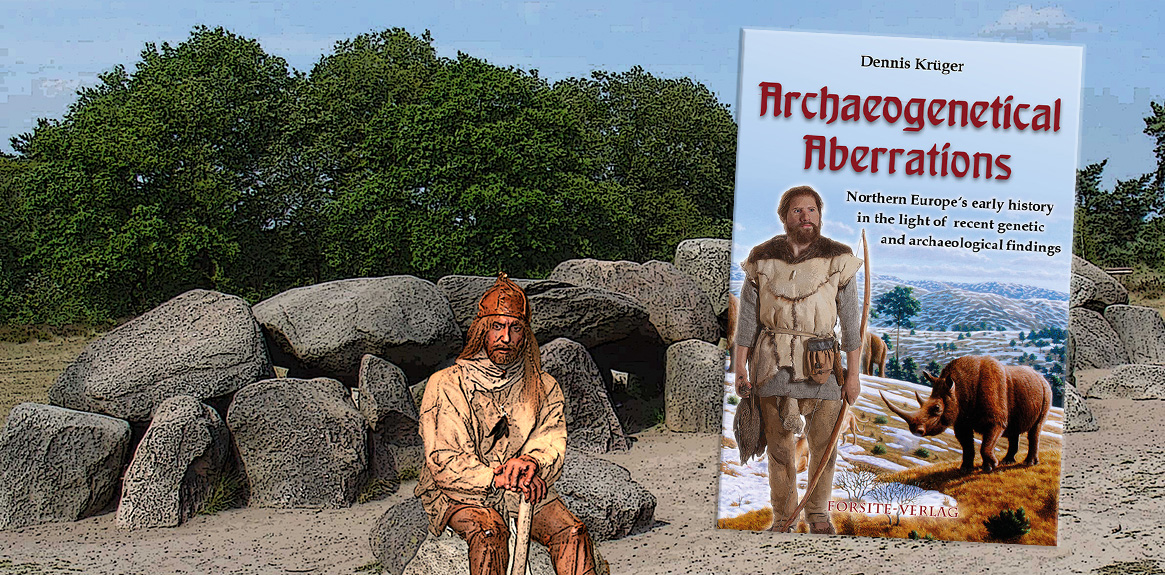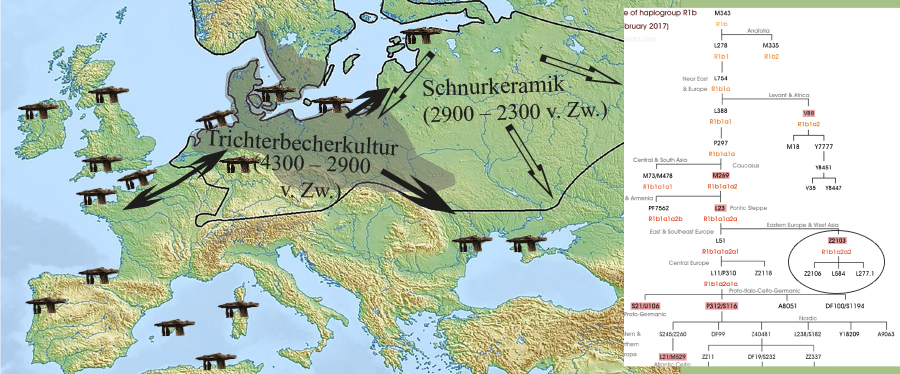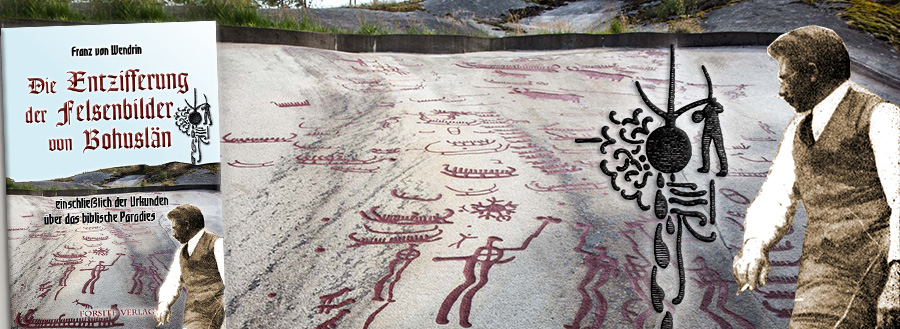The recently released publication „Archaeogenetical Aberrations“ is one of the very rare books that take a critical look at the “steppe hypothesis”, according to which we are descendants of an invasion of warlike cattle herders from south-eastern Europe. Why this is wrong shows a closer look at recent archoegenetic research…
Erroneous paths of research on the Y-haplogroup R
The main problem of the steppe theory is that, despite numerous studies of Yamnaja humans, to this day, neither a find of the Y-haplo group R1a nor of the Y-haplo subgroup R1b has been found that has become established in Europe: R1b1a1a2a-L51. The R1b types found all belong to the side branch Z2103, which ended in a dead end.1
Recent studies have not been able to change the picture either, but have strengthened the suspicion that the steppe thesis is wrong: a 5500 year old R1b(L388) find from Denmark – the oldest of the predominant European branch until today – does not contain any official steppe heritage, moreover, several I2 humans were found in the Yamnaja grave environment, which apparently came from Scandinavia and suggest that there must have been an immigration from northern Europe to the steppe areas before 3000 B.C., the earliest of which took place around 10,000 B.C.2
Papac et al. already formulated the current status in their study as follows: “Although it has been proposed that CW formed from a male-biased westward migration of genetically Yamnaya-like people…, no overlap in Y-chromosomal lineages (with the exception of a few nondiagnostic I2) has been found between the predominantly R1a-carrying CW and mainly R1b-Z2103–carrying Yamnaya males.“3
This obviously corresponds with more recent archaeological findings, which have established a close correspondence between the “Steinkistengrab“ (“stone box grave“) of Gölitzsch at the Saale district and a stone box grave 2300 km away in the Caucasus. On the basis of the finds of a copper ring, a battle axe, a fire stone blade and an amphora, which were stylistically attributed to the Corded Ware Culture, the excavators had assumed that the Gölitzsch grave originated at the beginning of the 3rd millennium, until analyses of the decorative patterns and similar graves belonging to the Bernburg Culture led to a re-dating to the last third of the 4th millennium.4 The wall stones of the tomb are decorated with red and black motifs, whereby the representation of a bow with quiver stands out. The same can be found in the stone box tomb of Klady, which can be attributed to the Maikop culture, so that the excavators in the Caucasus assume an influence from Central Europe.5
The R1b people, who later predominated in Western Europe, originated from the L51 branch (R1b1a1a2a1). Until recently, this haplotype was associated with the Bell Beaker culture. Two people of the Bell Beaker culture buried south of Lake Constance around 2500 B.C. were considered the earliest representatives.
Now, a recent study in Bohemia has for the first time located members of the R1b-L51 branch who belonged to the Corded Ware Culture. The six finds were dated to an age of about 4900 years. Contrary to the usual claim of “75 % steppe genetics“, they have an autosomal genetic composition, which identifies them as a mixture of indigenous, mainly female, an eastern component and a component from the Baltic States.6
At the same time, two R1b-L51 finds dating back about 5,000 years were made within the Afanasievo culture located between the Altai and the Himalayan mountains, which until the Danish find were considered the oldest representatives of this branch and seemingly supported an origin far to the east. The autosomal composition of the Bohemian finds also pointed to an eastern origin. A hypothesis based on this assumption sees the Sredni-Stog culture (4500-3500 B.C.) as the starting point of R1b-L51, whose two branches would have spread from here to Afanasievo and Yamnaya. However, this already seemed implausible because in this case it would not have been obvious why there should be no R1b-L51 within the steppe genome, which has been studied very comprehensively in the meantime. PCA modelling also showed that the Bohemian autosomal profile can best be explained by three components: A native, mainly female component, an eastern component and a Baltic component. Both R1b and the haplogroup R1a, typical for Corded Ware, are found early in the Baltic, whereas the latter is not found at all within steppe burials. In order to obscure this fact, there has recently been talk of a “forest steppe“ from which R1a people have penetrated into Europe. In addition, geneticists refer to the autosomal composition, which is said to show an average of 75% steppe content in Corded Ware.7 In fact, these are EHG shares, which are found in WHG, EHG and SHG people and are said to be largely descended from the group of Ancient North Eurasians (ANE), but are undoubtedly linked to north-eastern Europe.8
A study of the Globular Amphora Culture, which immediately preceded the Corded Ware and extended far to the south-east, also showed, contrary to all expectations, no high proportion of so-called steppe heritage.9
And despite the widespread opinion of scientists who see haplogroup R as a typically Asian group, R could even have originated in Europe. This is suggested by the lack of typical Asian physiognomies. In any case, the R precursor group P first appeared in the Bulgarian Batscho Kiro cave 32,500 years ago. The find there is older than the oldest find to date from the Russian Jana and already bears three mutations on the way from P to R. The Jana people and the boy from Mal‘ta would therefore be the result of a very early eastward migration.10
The most numerous subgroup of haplogroup R today, R1b, is even more likely to have originated in Europe and can be traced early in Europe: from 12,000 B.C. in Italy, from 10,000 in southern France and from 9,000 in the Balkans and Latvia – but it does not seem to have played an important role at first. The oldest finds from Germany are about 5,500 years old, but, unlike a contemporaneous Danish find, belong to branches that did not continue to the present day.11
Take a look at the book for further informations
Notes
1) R1a steppe finds are now available from Vasilevka (8825-8561 calBCE) and Dereivka, ca. 7040-6703 calBCE (mtDNA U5a2a), both bear mtDNA U5a. See https://indo-european.eu/2018/08/on-the-origin-and-spread-of-haplogroup-r1a-z645-from-eastern-europe.
2) Cf. Allentoft (2022), Supplementary Table I No. 291.
3) Papac et al (2021).
4) Schunke (2013), p. 152 f.
5) Schunke (2013), p. 155. Western archaeologists typically see a reverse influence. It is remarkable that Klady is also the site of one of the earliest (arsenic) copper swords in the world. The 63 cm long blade was found in a spa tomb and is dated to around 3200 B.C.; cf. Piller (2015), p. 283. Closely related HG-I2 finds from Central Europe and the Steppes mentioned by Papac (2021), supported the findings.
6) Papac (2021); Vgl. https://indo-european.eu/2021/08/r1b-rich-earliest-corded-ware-a-yamnaya-related-vector-of-indo-european-languages.
7) Haak (2015).
8) See also above, p. 61, FN 123 and p. 87, FN. 184.
9) Tassi (2017).
10) Cf https://anthrogenica.com/showthread.php?20265-Initial-Upper-Palaeolithic-Homo-sapiens-from-Bacho-Kiro-Cave-Bulgaria/page21&highlight=pribislav.
11) The c. 9200 year old Latvian R1b find (P-297) comes from Zvejnieki. Between 3,000 and 2,000 B.C., R1b became the dominant group in Western Europe, reaching population shares of up to 80% in Ireland, the Scottish Highlands, the French Atlantic coast and northern Spain. In Germany, their share today is 45%.



